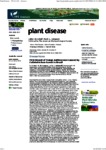Use este identificador para citar ou linkar para este item:
http://www.alice.cnptia.embrapa.br/alice/handle/doc/969206Registro completo de metadados
| Campo DC | Valor | Idioma |
|---|---|---|
| dc.contributor.author | LIMA, N. B. | pt_BR |
| dc.contributor.author | MARQUES, M. W. | pt_BR |
| dc.contributor.author | MICHEREFF, S. J. | pt_BR |
| dc.contributor.author | MORAIS JÚNIOR, M. A. | pt_BR |
| dc.contributor.author | BARBOSA, M. A. G. | pt_BR |
| dc.contributor.author | CÂMARA, M. P. S. | pt_BR |
| dc.date.accessioned | 2015-04-15T05:39:42Z | - |
| dc.date.available | 2015-04-15T05:39:42Z | - |
| dc.date.created | 2013-10-23 | pt_BR |
| dc.date.issued | 2013 | pt_BR |
| dc.identifier.citation | Plant Disease, v. 97, n. 9, p. 1248, sept. 2013. | pt_BR |
| dc.identifier.uri | http://www.alice.cnptia.embrapa.br/alice/handle/doc/969206 | pt_BR |
| dc.description | From April to June 2010, mango fruits (Mangifera indica L.) (cv. Tommy Atkins) showing post-harvest anthracnose symptoms were collected during a survey conducted in São Francisco Valley, northeastern Brazil. Fruits affected by anthracnose showed sunken, prominent, dark brown to black decay spots. Small pieces (4 to 5 mm) of necrotic tissues were surface sterilized for 1 min in 1.5% NaOCl, washed twice with sterile distilled water, and plated onto potato dextrose agar (PDA) amended with 0.5 g liter–1 streptomycin sulfate. Plates were incubated at 25°C in the dark for 5 to 7 days and colonies that were morphologically similar to species of Colletotrichum were transferred to PDA (1). Identification was made using morphological characteristics and phylogenetic analysis. Two isolates (CMM 4101 and CMM 4102) presented colonies that had white aerial mycelia and orange conidial mass, varying between colorless and pale orange in reverse. Conidia were hyaline, cylindrical, and aseptate 14.52 (10.40 to 20.20) μm long and 4.90 (3.80 to 6.50) μm wide, length/width ratio = 3.0. Mycelial growth rate was 5.20 mm per day at 25°C. Morphological and cultural characterizations were consistent with the description of Colletotrichum karstii (3). PCR amplification by universal primers (ITS1/ITS4) and DNA sequencing of the internal transcribed spacer (ITS1-5.8S-ITS2 rRNA gene cluster) were conducted to confirm the identifications. Analysis of representative sequences (GenBank Accession Nos. HM585409 and HM585406) suggested that the isolated pathogen was C. karstii. Using published ITS data for C. karstii (3), a phylogenetic analysis was made via Bayesian inference, which shows that the isolated fungi belong to the C. karstii clade. Sequences of the isolates obtained in this study were deposited in GenBank (KC295235 and KC295236), and cultures were deposited in the Culture Collection of Phytopathogenic Fungi of the Universidade Federal Rural de Pernambuco (CMM, Recife, Brazil). Pathogenicity tests were conducted with the C. karstii strains on mango fruits cv. Tommy Atkins. Mycelial plugs taken from the margin of actively growing colonies (PDA) of each isolate were applied in shallow wounds (0.4 cm in diameter) at the medium region of the each fruit. PDA discs without fungal growing were used as controls. Inoculated fruits were placed in plastic containers lined with paper towels wetted in distilled water. The containers were partially sealed with plastic bags to maintain high humidity and incubated at 25°C in the dark. The plastic bags and paper towels were removed after 24 h, and fruits were kept at the same temperature. The experiment was arranged in a completely randomized design with four replicates per treatment (isolate) and four fruits per replicate. Typical anthracnose symptoms were observed after 10 days in mango fruits. C. karstii was successfully reisolated from symptomatic mango fruits to fulfill Koch's postulates. C. karstiiwas previously described from Orchidaceae in southwest China and the United States (2,3). To our knowledge, this is the first report of C. karstii causing mango anthracnose in Brazil and worldwide | eng |
| dc.language.iso | eng | eng |
| dc.rights | openAccess | eng |
| dc.subject | Colletotrichum karstii | pt_BR |
| dc.title | First report of mango anthracnose caused by Colletotrichum karstii in Brazil. | pt_BR |
| dc.type | Artigo de periódico | pt_BR |
| dc.date.updated | 2015-04-15T05:39:42Z | pt_BR |
| dc.subject.thesagro | Manga | pt_BR |
| dc.subject.thesagro | Doença | pt_BR |
| dc.subject.thesagro | Antracnose | pt_BR |
| dc.subject.thesagro | Fungo | pt_BR |
| dc.subject.thesagro | Pós-Colheita | eng |
| dc.subject.thesagro | Mangifera Indica | eng |
| dc.subject.nalthesaurus | Disease control | eng |
| dc.subject.nalthesaurus | Mangoes | eng |
| dc.subject.nalthesaurus | Postharvest treatment | eng |
| dc.subject.nalthesaurus | Postharvest technology | eng |
| riaa.ainfo.id | 969206 | pt_BR |
| riaa.ainfo.lastupdate | 2015-04-14 | pt_BR |
| dc.identifier.doi | 10.1094/PDIS-01-13-0002-PDN | pt_BR |
| dc.contributor.institution | MARIA ANGELICA GUIMARAES BARBOSA, CPATSA. | pt_BR |
| Aparece nas coleções: | Artigo em periódico indexado (CPATSA)  | |
Arquivos associados a este item:
| Arquivo | Descrição | Tamanho | Formato | |
|---|---|---|---|---|
| Angelica20131.pdf | 256 kB | Adobe PDF |  Visualizar/Abrir |









